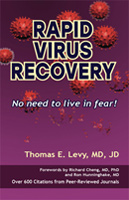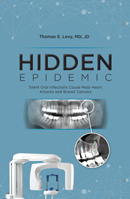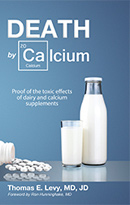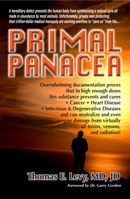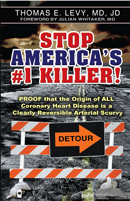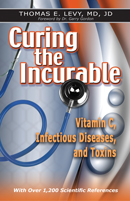Interview: Are Liposome-encapsulated Vitamin C and/or the Levy Multi-C Protocol more effective than Intravenous Vitamin C? - Part 2
Introduction: Below is part two of an interview between Dr. Richard A. Passwater, Ph.D. with Dr. Thomas E. Levy, M.D., J.D. that featured on the Wholefoods Magazine website on August 14th 2018.
As promised, we are continuing our chat with Dr. Tom Levy about the effectiveness of liposomal vitamin C (liposome-encapsulated vitamin C) compared to intravenous vitamin C and other forms of vitamin C supplements. Last month we discussed that additional health benefits can be achieved with high-dose vitamin C. However, the goal is not simply high blood levels of vitamin C, as is readily achieved with intravenous vitamin C. Instead, the goal is to deliver sufficient amounts of vitamin C into the cells and their interior components. As Dr. Levy pointed out, liposome-encapsulated vitamin C, even though taken orally, is more efficient at getting into the cells where it can do its work. As a result, oral liposome-encapsulated vitamin C appears to have comparable clinical effects to much larger doses of vitamin C given directly intravenously.Basically, the liposome permits a deep intracellular delivery of its contents via three mechanisms. When dealing with payloads comprised of nutrients like vitamin C, liposome-encapsulated delivery offers advantages that are not even offered by intravenous delivery, long considered the "gold standard" for nutrient and supplement bioavailability.
This month, Dr. Levy will discuss additional aspects of liposomal delivery and additional health benefits of high-dose vitamin C supplementation, as well as his Multi-C protocol for complete vitamin C optimization.
Levy: A plasma level that declines over time means cellular uptake, not renal excretion, as is the case with all other forms of vitamin C supplementation. Because of this, just looking at plasma levels of vitamin C is very misleading when trying to understand the physiology of liposome nutrient delivery. This point is illustrated by figures 1 and 2.
Figure 1. Much of the vitamin C that reaches the blood from oral or IV administration can be removed via kidney excretion before it is transported into cell interiors, an energy-requiring process.
Figure 2. The vitamin C contained in liposomal vitamin C supplements is delivered directly into cell interiors without the need for additional energy.
A review of the liposome literature indicates that when liposomes are small enough, many of them will be taken up directly by the ileals, the capillary equivalents in the lymphatic system. This allows many of the liposomes (percentage unknown) to bypass the portal circulation, go directly into the lymphatic circulation, assimilate into the many immune cells surrounding the gut, and eventually reach the systemic circulation via the thoracic duct when taken in sufficient quantities for a long enough period of time, thereby disseminating throughout the body.
Of note, most of the liposome literature addresses the intravenous delivery of encapsulated chemotherapeutic agents, and very little deals with the physiology of oral ingestion. However, clinical results indicate liposome-encapsulated vitamin C is vastly more impactful than equivalent doses of regular vitamin C orally and even equivalently-dosed intravenous vitamin C, as already mentioned earlier. The synopsis above does not represent solidly established liposome physiology, but more an interpretive hypothesis based on the existing literature and the powerful clinical impact of liposome-encapsulated nutrients.
Passwater: In review, when you give vitamin C intravenously, it is just that and nothing else. When you give vitamin C in a liposome, it is encapsulated and is an entirely different entity.
Let's see if I can summarize some of the points you have made about liposomal vitamin C.
- Taken orally with rapid and complete absorption (Ling 2006)
- Deep intracellular delivery of vitamin C, including delivery to mitochondria, endoplasmic reticula and nuclei. (Yamada 2008, Rawat 2007)
- Enhanced uptake by monocytes and white blood cells.
- Uptake and distribution throughout the body via lymphatic delivery to blood circulation.
- Energy-sparing delivery. Can reach the cytoplasm and subcellular organelles without the consumption of energy. IVC and regular non-lysosomal forms require substantial energy consumption before any of the vitamin C reaches the cytoplasm of cells. Vitamin C given intravenously requires energy consumption for the cellular uptake of the reduced form (DHA). Oxidized vitamin C is taken up without energy consumption, but then must consume energy in order to be reduced once it is in the cell. (Goldenberg 1994, Liang 2001, Meister 1994)
Dr. Levy, let's compare liposomal vitamin C to IVC in more detail. Why is it misleading to compare blood levels of vitamin C given via IVC and liposomal vitamin C?
Levy: One shouldn't compare apples to oranges. Removal of vitamin C from the blood can be either through kidney excretion or by cell uptake. Comparing blood levels achieved after IVC and the ingestion of an equal amount of vitamin C encapsulated in liposomes orally are of no value at all in comparing the biodelivery of the vitamin C, unless the testing is sophisticated enough to determine what percent of the vitamin C measured in the blood after liposome ingestion is still encapsulated in liposomes.
Additionally, such blood levels also mean nothing unless a simultaneous assessment can be made determining how much new vitamin C has already been delivered inside the cells of the body at the time the blood testing is done. It is unlikely the liposomes will circulate very long before penetrating cell walls throughout the body, delivering their payload of vitamin C and lowering the vitamin C level in the blood.
Clinical responses with liposome-encapsulated vitamin C can be comparable to larger doses of vitamin C given intravenously for some conditions.
Passwater: How did you come to use liposomal vitamin C?
Levy: About 12 years ago, LivOn Laboratories asked me to try out their new product, liposome-encapsulated vitamin C, as they knew I had worked with and written about vitamin C over an extended period. Quite honestly, I had never heard of a liposome, and I wasn't particularly interested in spending any time trying to learn about the subject. However, one thing LivOn told me in that initial conversation was that the product did not have the loose bowel-inducing effect, as it was generally completely absorbed long before it reached the colon.
They sent me some product, and I put it in my kitchen cabinet, doubting I would even be inclined to use it.
Then, a few months later, I came down with a bad case of the flu. I had recently closed my clinic to do full-time research and lecturing, so I did not have my usual access to intravenous vitamin C. After dosing up with enough regular vitamin C orally to be continually in the bathroom, I began to wonder what I could do, as I was feeling no better at all.
I then remembered the assertion that the liposome C did not have the bowel effect, so I decided to take 5 packets (5 grams of encapsulated vitamin C) to see if getting the vitamin C levels a little higher in my body might give me some relief.
Within 45 minutes to an hour, I was having a difficult time remembering how sick I had felt, as I was beginning to feel so good. I proceeded to take even more packets, and I ended up overcoming a severe cold/flu more quickly than I ever had before, even when I had access to multiple 50- to 100-gram infusions of vitamin C intravenously. Since it was so unbelievable to think that a much lesser dose of an oral vitamin C product could surpass the positive clinical impact of a much larger dose of C intravenously, I took my only logical approach: I wrote it off as an aberration that was not to be taken too seriously. Maybe all the oral C I had taken finally kicked in?
However, I then witnessed similar scenarios later again in myself, and then with some friends/family members, and I decided I better figure out what liposomes were all about. Because of this experience, which has since been enhanced by feedback that I have received from patients, physicians, dentists, and healthcare practitioners around the world, I became a consultant to LivOn Laboratories, furthering research on the product and talking at conferences around the world about vitamin C, liposomes, and related topics.
Passwater: I think some manufacturers may be confused by what a true liposomal-encapsulated nutrient is. What are the requirements that a consumer should look for? Can a liposome be formed in the gut from precursor ingredients?
Levy: Since liposome-like structures are formed in the body all the time, as noted above, it's hard to say what the conditions might be in the body that could facilitate the formation of a liposome-like extracellular vesicle. However, it does not appear that forming legitimate liposomes outside of the body for supplementation could be a simple process.
It appears there is fraud, intentional or otherwise, in the liposome supplementation industry. Many purported products simply have no liposomes. However, the process of testing a product for liposome size and content is so costly that the absence of liposomes is rarely detected, and the outpouring of fraudulent products continues largely unabated. All my experience is with LivOn, and I cannot attest to the quality of any other liposome manufacturer. Of course, I also cannot say if a few of those companies do put out a quality product.
Passwater: In 2012, we discussed the treatment of sepsis with vitamin C. Sepsis, sometimes called "septic shock" or "blood poisoning," is a severe illness in which the bloodstream is overwhelmed by bacteria. Sepsis is caused by a bacterial infection that can begin anywhere in the body. Immune chemicals released into the blood to combat the infection trigger widespread inflammation, which leads to blood clots and leaky vessels. This results in impaired blood flow, which damages the body's organs. In sepsis, blood pressure drops, resulting in shock. Major organs and body systems, including the kidneys, liver, lungs and central nervous system, stop working properly. Recently, I read your Orthomolecular Medicine News release on sepsis. What were the important points in the release?
Levy: The work of Dr. Paul E. Marik of the Eastern Virginia Medical School in Norfolk clearly demonstrated that small doses of hydrocortisone, vitamin C and thiamine could reduce the 40% to 50% mortality of sepsis in the hospitalized setting to near-zero. However, another lesser known study showed that similarly-dosed vitamin C by itself had a similar effect on saving patients from sepsis. It would appear that the thiamine was not a consequential part of the sepsis treatment protocol.
As it turns out, high endogenous cortisol levels are present in septic patients near-death, as the body-wide oxidation of intracellular hydrocortisone receptors seen in advanced sepsis causes a state of cortisol resistance, resulting in an attempted compensation by the body to produce more cortisol in a futile attempt to result in active, cortisol-bound receptors having their normal physiological impact in the nuclei of the cells throughout the body.
What appears to happen, then, is that the initial dose of vitamin C reduces the oxidized receptors, and the cortisol effect then kicks in as the receptors again become functional. Furthermore, the cortisol itself facilitates the intracellular uptake of vitamin C via increased expression of SVCT2 vitamin C transporters, making vitamin C and hydrocortisone very synergistic in their clinical impact.
It appears that vitamin C and hydrocortisone are the two most important and powerful naturally-occurring anti-inflammatory agents.
Passwater: Vitamin C and sepsis will be the subject of upcoming columns. Let's go back to our 2012 discussion, when we were concerned with the actions of governments to limit the availability of injectable vitamin C. You pointed out that not too long after the airing of your interview "Living Proof?" on New Zealand's 60 Minutes program, FDA shut down the mass production of injectable vitamin C by McGuff Pharmaceuticals, which was the company name clearly visible on the vial of vitamin C visually featured on that program. Since then, FDA has "allowed" vitamin C orders to be separately "formulated" by the McGuff compounding pharmacy, as well as by other compounding pharmacies in the United States. Merit Pharmaceuticals also sells injectable vitamin C, although, to my knowledge, all of that vitamin C is produced by Bioniche Pharmaceuticals in Ireland. All of these "interventions" by FDA have only served to make injectable vitamin C more expensive, which would represent a good initial goal for FDA, as it always appears FDA will do anything to make Big Pharma happier. However, it would still be wonderful if FDA would stop its apparent agenda to ultimately ban vitamin C, although I doubt this is likely. Probably the "best" ultimate outcome will be that vitamin C ends up being available only through prescription. Has the situation improved today?
Levy: Actually, it has improved. After a lengthy approval process with the FDA, McGuff can now sell pre-formulated 25-gram vials of vitamin C for injection in unlimited quantities, at roughly $25 per vial.
I have also been involved in a few medical and dental board cases involving physicians and dentists giving vitamin C intravenously. After my testimony was submitted regarding the solidly-established scientific basis for vitamin C being part of a protocol for healing and infection resolution, two cases were rapidly resolved, and undesirable outcomes were avoided. The General Dental Council in the UK reported that they accepted as fact the testimony that I submitted regarding the use of intravenous vitamin C via video deposition with the Council. Similarly, the Texas Medical Board dropped a case a week after receiving a written report from me demonstrating the scientific validity of including vitamin C in protocols for the treatment of infections.
It is my opinion that the education of not only the public, but also of many physicians via the Internet may have "changed the game" forever. Certainly, every Board member has family and friends, and many of them take many supplements. I suspect such a Board member, at some level, wants to avoid the negative judgment of family members who might be shocked that a physician was chastised or lost a license because of administering vitamin C to a patient. However, it is also important to remember that once a complaint has been filed, a Board must go through a prescribed process before dismissing a case. Today, I think many Boards are looking for an excuse to resolve such a case once they have been given some scientific information.
However, much more needs to be done to get vitamin C readily available in all hospitals. And I believe Dr. Marik's work has gone a long way to help realize this goal.
Passwater: Also in our 2012 discussion, you recommended adding insulin to the IV bags in what you call the HEAT form of ascorbate therapy (Hormone Enhanced Ascorbate Therapy). The insulin allows a tremendously increased delivery of vitamin C to the intracellular area. Please update us on your thoughts with the HEAT form of IVC therapy.
Levy: While research on this subject is yet to be published, Dr. Ron Hunninghake of the Riordan Clinic and I have been working on models of enhancing vitamin C uptake inside the cells with not only insulin, but also hydrocortisone. It appears that after ingestion of vitamin C orally, the intravenous administration of hydrocortisone results in large increases in intracellular vitamin C levels. Furthermore, Marik's work indicates that perhaps much lower amounts of vitamin C (a few grams) given much more frequently (every 4 to 6 hours) could be substantially more effective than much larger amounts of vitamin C (50 to 100 grams) given over an hour or two. Along these lines, Dr. Hunninghake and I are pursuing clinical research involving the steady infusion of vitamin C periodically spiked by multigram vitamin C IV pushes for a variety of conditions. Of note, Dr. Klenner speculated many years ago that giving 300 grams of vitamin C infused around the clock could be especially impactful on cancer and other chronic diseases. Dr. Klenner's genius still amazes me.
Passwater: Me, too. What is even more amazing is that his work has been ignored. Now let's discuss your "Multi-C Protocol." What is it and how did it come about?
Levy: The Multi-C Protocol simply attempts to achieve what I call body-wide vitamin C saturation. It involves:
Oral liposome-encapsulated vitamin C, which helps to optimize cytoplasmic and intracellular organelle vitamin C levels. Since all diseases feature increased intracellular oxidative stress, this is especially important. Furthermore, the uptake of vitamin C deep into the cells effectively makes liposome-encapsulated vitamin C a "long-acting" form of vitamin C, relative to otherwise being in the blood and subject to rapid excretion by the kidneys.
Sodium ascorbate powder in water or juice taken to bowel tolerance on a daily basis also helps saturate the immune cells surrounding the gut with vitamin C, while gut toxins resulting from poor digestion are neutralized and flushed out on a daily basis.
Ascorbyl palmitate is a fat-soluble form of vitamin C that helps to give antioxidant presence to areas such as the fatty cores of the cell membranes, lessening and repairing oxidative damage there.
IV vitamin C as often as is possible for a given patient also goes a long way in saturating the extracellular spaces, which are also characterized by increased oxidative stress in most patients with significant chronic diseases.
Intramuscular vitamin C is my relatively recent addition to the Multi-C Protocol. Dr. Klenner showed that even a few grams of vitamin C given in this fashion was just as effective as IVC in babies and small children. The pharmacokinetics keeps a sustained level of vitamin C entering the circulation in a more effective fashion than IV.
Passwater: What is the recommended protocol for someone wishing to optimize their vitamin C blood level?
Levy: There is no simple answer to this question. When dealing with an illness or condition not responding in an optimal clinical fashion to the highest doses of one form of vitamin C, it is nearly always reasonable, depending mostly on the economic status of the patient, to adopt as many parts of the Multi-C Protocol as possible. When someone feels they are in an optimal clinical state, it is also important to determine that the normalization of critical laboratory tests has taken place as well. Other supplements are very critical in optimizing health as well, including magnesium, vitamin D, vitamin K, the B vitamins, and iodine. Restoring normal levels of sex hormone and thyroid to solidly normal levels is also extremely important. Vitamin C should never really be a "monosupplement."
Passwater: Where can readers find more information on your Multi-C Protocol?
Levy: There are many articles on the Protocol and other related issues on my website, www.tomlevymd.com
Passwater: What about your personal vitamin C program?
Levy: I usually take two packets of LivOn liposome C and a large teaspoon of a vitamin C powder called Cardio-C (Vitamin C Foundation) that also contains lysine and proline powder for a good anti-atherosclerotic effect on a daily basis.
Passwater: Thank you once again, Dr. Levy, for your enlightening discussion about optimizing vitamin C delivery into cells.
About this interview
This was part two of a two part interview between Dr. Richard A. Passwater, Ph.D. with Dr. Thomas E. Levy, M.D., J.D. that featured on the Wholefoods Magazine website on August 14th 2018. More articles from Dr. Passwater can be found on the Wholefoods Magazine website.


